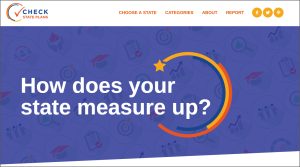The Best ESSA State Plan Ideas are Now Available: Put Them to Use

On June 27, 2017 Jim Cowen, Executive Director of the Collaborative for Student Success, released the following memo on the release of a peer review of 17 states’ ESSA plans.
Today is a big day.
About ten weeks ago, we announced a partnership with Bellwether Education Partners to conduct an independent peer review of the state accountability plans required under the Every Student Succeeds Act (ESSA). Since that time, 17 submitted plans and we convened more than 30 experts to review each of the plans. The project was initially reported by The 74.
Our goal was to go beyond the compliance function of the U.S. Department of Education by promoting the best practices within each plan and identifying any evident weaknesses. I am not aware of any other similar independent peer review process of these ESSA state plans, though certainly many groups are reviewing with their own lenses.
With delivery of the full report today, I am very pleased to tell you that we are fulfilling that purpose.
I will not say much about the details of the compiled plans and process, as you can read the original report here, or read it in various iterations on our new website, CheckStatePlans.org.
The most important outcome of our peer review process is this: With this information, the 17 states that have already submitted a report can improve it, the 34 states that will submit a report in September can apply our recommendations, advocates in these states can use this independent analysis to help move their states in the right direction and – most importantly – once implemented, we believe these ideas will demonstrably improve classroom results for students, parents, and teachers.
Also, I did want to tell you three reasons why you should put considerable faith in these suggestions:
#1. The people and the process were first rate.
Ultimately, we assembled more than 30 experts representing a wide range of philosophies, areas of expertise, backgrounds, political parties, and home states. Beyond just an outstanding group of experts, I can vouch for their total dedication to providing meaningful feedback. Each state was reviewed by three to five different peer reviewers and content specialists focused on the unique challenges of students with disabilities and English Learners, who read their state plans in advance, and then assembled in early May to trade notes and reconsider their observations; significant time was spent focusing as a group on each state. Read more about the experts and their collaborative process here.
#2. States have carefully considered these suggestions.
After consolidating the peer reviewers’ recommendations, we shared a draft copy with state officials. Because our exercise has never been intended to embarrass states, but instead to highlight best practices and areas where states can improve, we wanted to give these policymakers an opportunity to review draft reports and provide any additional information that would help inform our analysis. As evidence that these state officials welcomed our constructive feedback, all 17 acknowledged our analysis and nearly every one participated in an exchange of additional context about their decision making process, priorities and other local considerations.
#3. Ultimately, the recommendations are sound.
No peer review is valuable unless it results in clear, actionable suggestions, so that is exactly what we have done individually for the initial 17 states, plus provided outstanding best practices for the 34 states that will submit in September. In the end, the most consequential outcome of our process is that every state now has access to the best ideas, thus far put forward, consolidated in one spot.
What is next for us? What will we do to follow-up this report?
First, we are going to work hard to ensure widespread awareness of our recommendations by policymakers, media, and the thousands of stakeholders in every state. On this task, we ask for your help: people who care about student performance in every state need to know about these best practices and should encourage policymakers to adopt and implement these ideas. We will also work with in-state advocates to raise awareness on the plan components that can and should be improved to promote equity and ensure broader student success.
Second, we welcome ideas on how to improve our process because we intend to review and analyze the 34 state plans that will be submitted in September. As you would expect, nothing would make us more satisfied than to see the best ideas incorporated into this second set of ESSA plans, or see the initial seventeen update their plans to reflect a few of the peer reviewers’ suggestions. To this end, we particularly ask for your help in identifying qualified individuals to serve as additional expert peer reviewers in our second-round process. Your recommendations on individuals with expertise in the design, implementation or study of accountability systems are welcomed and encouraged.
Finally, thank you for the crucial role that you play in promoting good policy. Let’s work together to lay the foundation for a better education for every kid.
About the Collaborative for Student Success
At our core, we believe leaders at all levels have a role to play in ensuring success for K-12 students. From ensuring schools and teachers are equipped with the best materials to spotlighting the innovative and bold ways federal recovery dollars are being used to drive needed changes, the Collaborative for Student Success aims to inform and amplify policies making a difference for students and families.
To recover from the most disruptive event in the history of American public schools, states and districts are leveraging unprecedented resources to make sure classrooms are safe for learning, providing students and teachers with the high-quality instructional materials they deserve, and are rethinking how best to measure learning so supports are targeted where they’re needed most.


